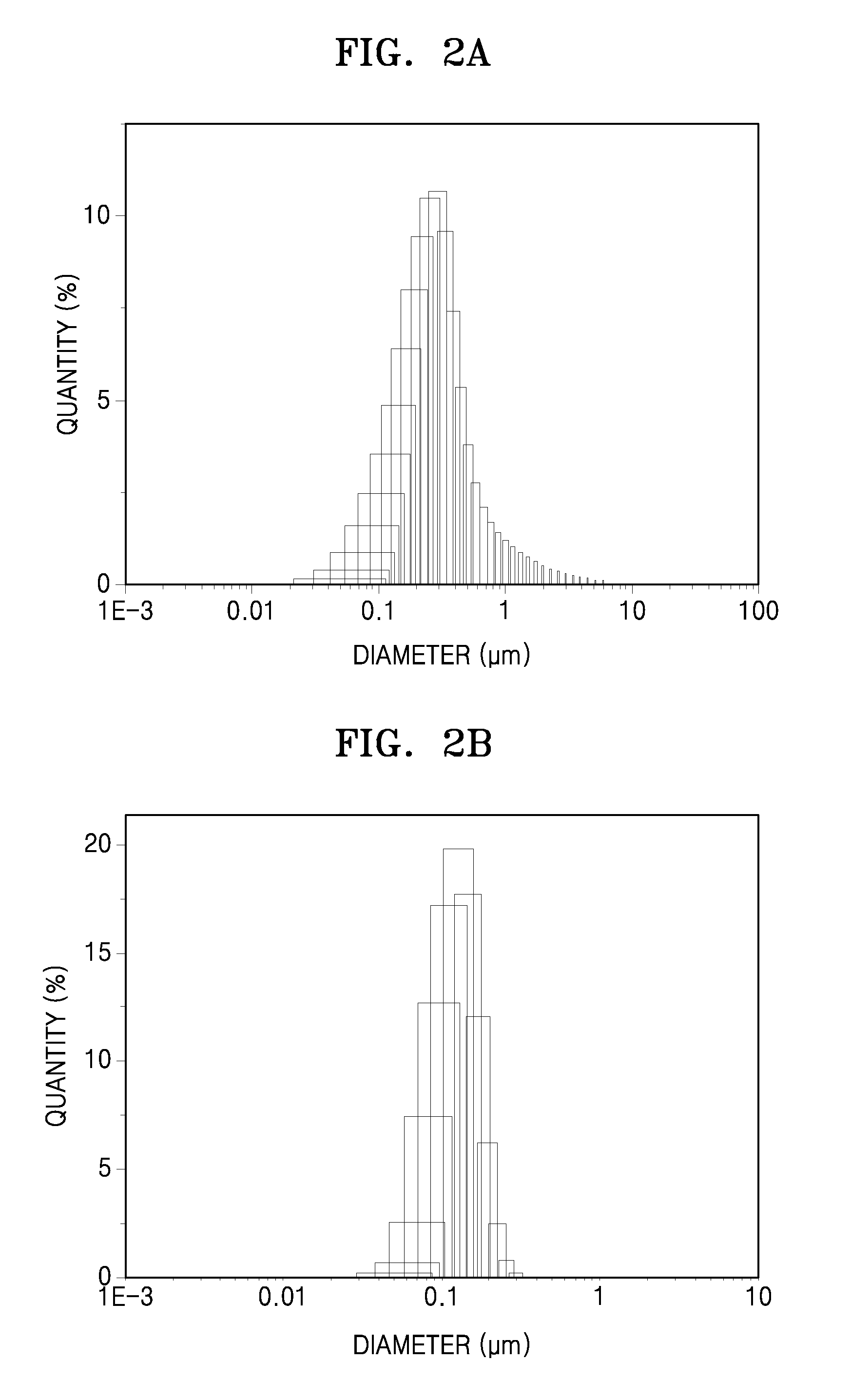Electrolyte membrane for energy storage device, energy storage device including the same, and method of preparing the electrolyte membrane for energy storage device
- Summary
- Abstract
- Description
- Claims
- Application Information
AI Technical Summary
Benefits of technology
Problems solved by technology
Method used
Image
Examples
preparation example 1
Preparation of Metal-Organic Framework (MIL-125(Ti8O8(OH)4(BDC)6), H2BDC=1,4-benzenedicarboxylate)
[0145]Titanium isopropoxide (99.8%, available from Signal Aldrich as a metal ion precursor and 1,4-benzenedicarboxylic acid (H2BDC, 99%, available from Aldrich) as an organic ligand precursor were added to 50 mL of a mixed solvent (9:1, v / v) of N,N-dimethylformamide (DMF, available from Aldrich) and methanol to have a final reaction mole ratio of about 1:14.85 of 1,4-benzenedicarboxylic acid to titanium isopropoxide that is higher than a stoichiometric mole ratio of 1:0.75 thereof.
[0146]The resulting mixture was put in a reactor, which was then thermally treated in an oven at about 150° C. for about 24 hours, followed by cooling down to room temerapture, and washing the remaining unreacted organic ligand with N,N-dimethylformamide and then with methanol, each three times, and filtering to obtain a precipitate as white solid powder. The precipitate was dried in an oven at 60° C. under va...
preparation example 2
Preparation of metal-organic framework (MIL-53 (Al(OH)(O2C—C6H4—CO2))
[0147]Aluminum nitrate nonahydrate, 98%, available from Sigma Aldrich) as a metal ion precursor and 1,4-benzenedicarboxylic acid (H2BDC, 99%, available from Sigma Aldrich) as an organic ligand precursor were added to 50 mL of N,N-dimethylformamide (DMF, available from Sigma Aldrich) to have a final reaction mole ratio of about 1:2 of 1,4-benzenedicarboxylic acid to aluminum nitrate nonahydrate that is higher than a stoichiometric mole ratio of 1:1 thereof.
[0148]The resulting mixture was put in a reactor, which was then thermally treated in an oven at about 150° C. for about 24 hours, followed by cooling down to room temerapture, and washing the remaining unreacted organic ligand with N,N-dimethylformamide and then with methanol, each three times, and filtering to obtain a precipitate as white solid powder. The precipitate was dried in an oven at 60° C. under vaccum for about 24 hours, thereby preparing a metal-orga...
example 1
Analysis Example 1
Electroscanning Microscopy (SEM)
[0166]The metal-organic frameworks of Preparation Example 1 and Comparative Preparation Example 1 were observed by scanning electron microscopy (SEM) using a Mini-SEM SNE-3000MB (available from SEC Co., Ltd.). The results thereof are shown in FIGS. 1A and 1B, respectively.
[0167]Referring to FIG. 1A, the metal-organic framework of Preparation Example 1 was found to include a plurality of primary particles having a uniform spherical shape and a uniform diameter of about 400 nm. Referring to FIG. 1B, the metal-organic framework of Comparative Preparation Example 1 was found to include a plurality of primary particles in various forms, for example, a rectangular, elliptical, dumbbell, or thin-film shape and having a diameter or size of about 10 nm to 2 μm or larger, and a plurality of secondary particles agglomerated from the primary particles.
PUM
| Property | Measurement | Unit |
|---|---|---|
| particle diameter | aaaaa | aaaaa |
| weight average molecular weight | aaaaa | aaaaa |
| ionic conductivity | aaaaa | aaaaa |
Abstract
Description
Claims
Application Information
 Login to View More
Login to View More - R&D
- Intellectual Property
- Life Sciences
- Materials
- Tech Scout
- Unparalleled Data Quality
- Higher Quality Content
- 60% Fewer Hallucinations
Browse by: Latest US Patents, China's latest patents, Technical Efficacy Thesaurus, Application Domain, Technology Topic, Popular Technical Reports.
© 2025 PatSnap. All rights reserved.Legal|Privacy policy|Modern Slavery Act Transparency Statement|Sitemap|About US| Contact US: help@patsnap.com



